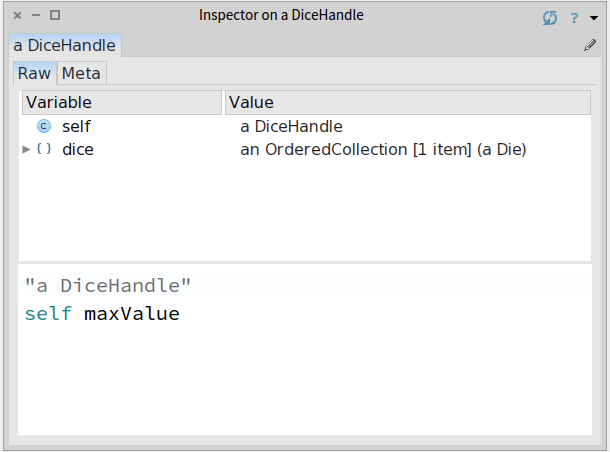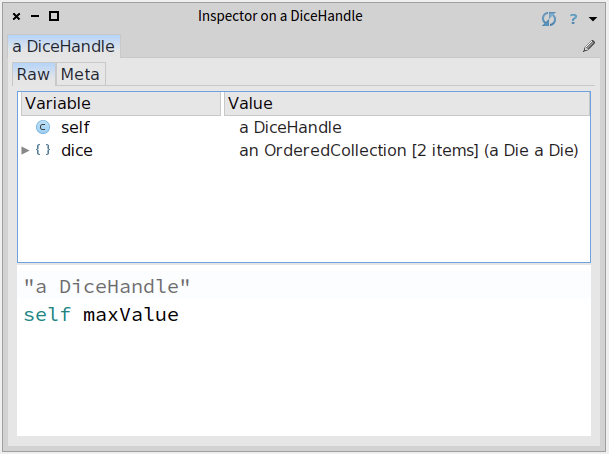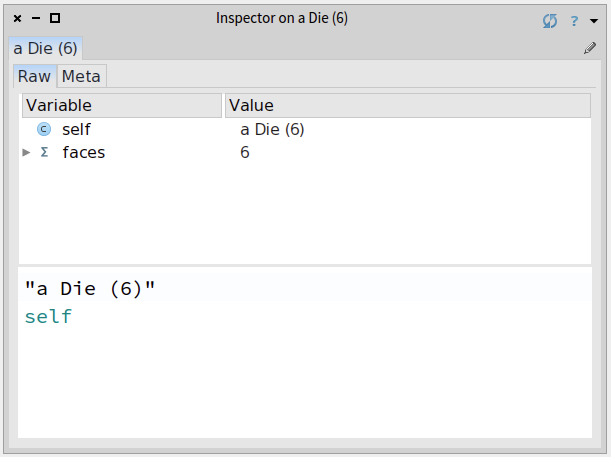43. Crafting a Simple Embedded DSL with Pharo
In this chapter we will develop a simple domain specific language (DSL) for rolling dice. Players of games such as Dungeon and Dragons are familiar with the DSL we will implement. An example of such DSL is 2 D20 + 1 D6 which means that we should roll two 20-faces dice and one 6 faces die. This tutorial shows how we can (1) simply reuse traditional operator such as +, (2) develop an embedded DSL and (3) use class extensions (aka open classes).
43.1. Getting started
Using the code browser, define a package named Dice or any name your like.
43.1.1. Defining the class Die
Object subclass: #Die
instanceVariableNames: 'faces'
classVariableNames: ''
package: 'Dice'
In the initialization protocol, define the method initialize as follows. It simply sets the default number of faces to 6.
Die >> initialize
super initialize.
faces := 6Do not hesitate to add a class comment.
43.1.2. Creating a test
It is always empowering to verify that the code we write is always working as we defining it. For this purpose we will create a unit test. Remember unit testing was promoted by K. Beck first in Smalltalk the ancestor of Pharo. Nowadays this is a common practice but this is always useful to remember our roots!
So we define the class DieTest as a subclass of TestCase.
TestCase subclass: #DieTest
instanceVariableNames: ''
classVariableNames: ''
package: 'Dice'DieTest >> testInitializeIsOk
self shouldnt: [ Die new ] raise: Error43.2. Rolling a die
To roll a die we will use the method from Number atRandom which draws randomly a
number between one and the receiver. For example 10 atRandom draws number between 1 to 10.
Therefore we define the method roll as follows.
Die >> roll
^ faces atRandom
Now we can create an instance Die new and send it the message roll and get a result.
Do Die new inspect and then type in the bottom pane self roll.
You should get an inspector like the one shown in Figure 43.1. With it you can interact with a die by writing expression in the bottom pane.

43.2.1. Creating another test
We will define a test that verifies that rolling a new created dice with a default 6 faces only returns value comprised between 1 and 6. This is what the following test method is actually specifying.
DieTest >> testRolling
| d |
d := Die new.
10 timesRepeat: [ self assert: (d roll between: 1 and: 6) ]Note that often it is better to define the test even before the code it tests. Why? Because you can think about the API of your objects and a scenario that illustrate their correct behavior. It helps you to program your solution.
43.3. Instance creation interface
We would like to get a simpler way to create Dice. For example we want to create a 20-faces die as follows: Dice faces: 20. Let us define a test for it.
DieTest >> testCreationIsOk
self shouldnt: [ Die faces: 20 ] raise: Error
We define the class method faces: as follows. It creates an instance then send the message faces: to it and returns the instance.
Die class >> faces: aNumber
| instance |
instance := self new.
instance faces: aNumber.
^ instance
This method is strictly equivalent to the one below. The trick is that yourself is a simple method defined on Object class. yourself returns the receiver of a message and the use of ; sends the message to the receiver of the previous message (here faces:), therefore yourself is sent to the object resulting from the execution of the expression self new (which returns a new instance of the class Dice).
Die class >> faces: aNumber
^ self new faces: aNumber; yourself
If you execute it will not work since we did not create yet the method faces: this is now the time to define it.
Die >> faces: aNumber
faces := aNumberNow your tests should run.
So even if the class Die could implement more behavior, we are ready to implement a dice handle.
43.4. First specification of a dice handle
Let us define a new class DiceHandle that represents a dice handle.
Here is the API that we would like to offer for now. We create a new instance of the handle then add some dice to it.
DiceHandle new
addDie: (Die faces: 6);
addDie: (Die faces: 10);
yourself
Of course we will define a test for this new class. We define the class DiceHandleTest as follow.
TestCase subclass: #DiceHandleTest
instanceVariableNames: ''
classVariableNames: ''
package: 'Dice'43.4.1. Testing a Dice Handle
We define a new test method as follows.
DiceHandleTest >> testCreationAdding
| handle |
handle := DiceHandle new
addDie: (Die faces: 6);
addDie: (Die faces: 10);
yourself.
self assert: handle diceNumber = 2.In fact we can do it better and add a new test method that verifies that we can even add two dice having the same number of faces.
DiceHandleTest >> testAddingTwiceTheSameDice
| handle |
handle := DiceHandle new.
handle addDie: (Die faces: 6).
self assert: handle diceNumber = 1.
handle addDie: (Die faces: 6).
self assert: handle diceNumber = 2.43.4.2. Defining the DiceHandle class
This class defines one instance variable to hold dice it contains.
Object subclass: #DiceHandle
instanceVariableNames: 'dice'
classVariableNames: ''
package: 'Dice'
We simply initialize it so that its instance variable dice contains an OrderedCollection.
DiceHandle >> initialize
super initialize.
dice := OrderedCollection new.Then we define a simple method to add a die to the list of dice of the handle.
DiceHandle >> addDie: aDie
dice add: aDieNow you can execute the code snippet and inspect it. You should get an inspector as shown in Figure 43.2
DiceHandle new
addDie: (Die faces: 6);
addDie: (Die faces: 10);
yourself

Finally we should add the method diceNumber to the DiceHandle class to be able to get the number of dice of the handle. We just return the size of the dice collection.
DiceHandle >> diceNumber
^ dice sizeNow your tests should run and this is good moment to save and publish your code.
43.5. Improving programmer experience
Now when you open an inspector you cannot see well the dice that compose the dice handle. Click on the dice instance variable and you will only get a list of a Dice without further information.
DiceHandle new
addDie: (Die faces: 6);
addDie: (Die faces: 10);
yourself
So we will enhance the printOn: method of the Die class to provide more information. Here we simply add the number of faces surrounded by parenthesis.
Die >> printOn: aStream
super printOn: aStream.
aStream nextPutAll: ' (', faces printString, ')'Now in your inspector you can see effectively the number of faces a dice handle has as shown by Figure 43.3 and it is now easier to check the dice contained inside a handle (See Figure 43.4).
43.6. Rolling a dice handle
Now we can define the rolling of a handle of dice by simply summing the dice rolls.
DiceHandle >> roll
| res |
res := 0.
dice do: [ :each | res := res + each roll ].
^ res
Now we can send the message roll to a dice handle.
handle := DiceHandle new
addDie: (Die faces: 6);
addDie: (Die faces: 10);
yourself.
handle roll43.7. Role playing syntax
Now we are ready to offer a syntax following practice of role playing game, i.e., using 2 D20 to create a handle of two 20 faces dice. For this purpose we will define class extensions: we will define methods in the class Integer but these methods will be only available when the package Dice will be loaded.
But first let us specify what we would like to obtain by writing a new test in the class DiceHandleTest. Remember
to always take any opportunity to write tests. When we execute 2 D20 we should get a new handle composed of two
dice and can verify that. This is what the method testSimpleHandle is doing.
DiceHandleTest >> testSimpleHandle
self assert: 2 D20 diceNumber = 2.
Verify that the test is not working! It is much more satisfactory to get a test running when it was not working before. Now define the method D20 with a category name that is '*Dice' (if you named your package Dice). This method simply creates a new dice handle, add the correct number of dice to this handle and return it.
Integer >> D20
| handle |
handle := DiceHandle new.
self timesRepeat: [ handle addDie: (Die faces: 20)].
^ handleNow you test should pass and this is probably a good moment to save your work either by publishing your package to SmalltalkHub and to save your image.
Now we could do the same for the default dice with different faces number: 4, 6, 10, and 20.
But we should avoid duplicating logic and code. So first we will introduce a new method D: and based on it we will define all the others
Integer >> D: anInteger
| handle |
handle := DiceHandle new.
self timesRepeat: [ handle addDie: (Die faces: anInteger)].
^ handleInteger >> D4
^ self D: 4Integer >> D6
^ self D: 6Integer >> D10
^ self D: 10Integer >> D20
^ self D: 20We have now a compact form to create dice and we are ready for the last part: the addition of handles.
43.7.1. Handle's addition
Now we can simply support the addition of handles. But of course let's write a test first.
DiceHandleTest >> testSumming
| handle |
handle := 2 D20 + 3 D10.
self assert: handle diceNumber = 5.
We will define a method + on the HandleDice class. In other languages this is often not possible or is based on operator overloading. In Pharo + is just a message as any other, therefore we can define it on the classes we want.
Now we should ask ourself what is the semantics of adding two handles. Should we modify the receiver of the expression or create a new one. We preferred a more functional style and choose to create a third one.
The method + creates a new handle then add to it the dice of the receiver and the one of the handle passed as argument to the message. Finally we return it.
DiceHandle >> + aDiceHandle
| handle |
handle := self class new.
self dice do: [ :each | handle addDie: each ].
aDiceHandle dice do: [ :each | handle addDie: each ].
^ handle
Now we can execute the method (2 D20 + 1 D6) roll nicely and start playing role playing games, of course.
43.8. Conclusion
This chapter illustrates how to create a small DSL based on the definition of some domain classes (here Dice and
DiceHandle) and the extension of core class such Integer.
It shows that in Pharo we can use usual operators to express natural models.

